America's Flakiest Collectibles
by Bob Brooke
QUESTION:
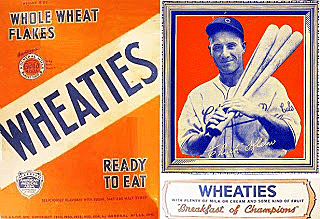 Ever
since I was a kid, I’ve been fascinated by cereal boxes. I didn’t have a
favorite cereal, so I ate just about any kind and got to see a lot of
different box designs. My favorite thing was hunting for those with
prizes inside. Do people collect cereal boxes? And do they have any
value as a collectible? Ever
since I was a kid, I’ve been fascinated by cereal boxes. I didn’t have a
favorite cereal, so I ate just about any kind and got to see a lot of
different box designs. My favorite thing was hunting for those with
prizes inside. Do people collect cereal boxes? And do they have any
value as a collectible?
Thanks,
Jerry
__________________________________________________________
ANSWER:
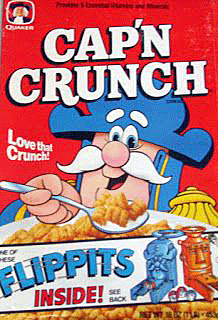 You’re
not alone. While there aren’t hundreds of collectors of cereal boxes,
those that do are somewhat fanatical about it. They, too, remember the
boxes from when they were kids. And that’s what drives them today. You’re
not alone. While there aren’t hundreds of collectors of cereal boxes,
those that do are somewhat fanatical about it. They, too, remember the
boxes from when they were kids. And that’s what drives them today.
As a kid, hasn’t everyone stared at a cereal box at one time or another
at breakfast? Many kids recalled the commercials they saw on Saturday
morning T.V., then harassed their moms until they finally gave in and
bought that cereal so they could get the prize inside. From then on,
their moms would chide them with, “You begged me to buy that cereal, so
now, damn it, you better eat it.” Siblings all over America fought over
the little prizes they found in cereal boxes. Winners got to shove their
hand into the box to collect their victory in the form of a paper or
cellophane-wrapped toy. Those were the days.
Just about everyone grew up with cereal boxes. And today, a small group
of dedicated collectors cherish them because they bring back fond
memories of their childhood. And that’s the key reason people collect
cereal boxes—for the nostalgia.
One collector paid $450 for a box of cereal—just for the box. To cereal
box collectors, $450 isn’t much at all. An unopened package of Post
Ten—the now-defunct variety pack of mini cereal boxes dating back to
1961—once sold for $2,550 on eBay.
The Origins of Today’s Cereals
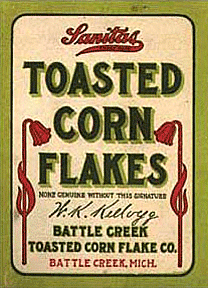 Descended
from its early ancestor, porridge, the first cold breakfast cereal was
invented in the U.S. in the 1860s. Called Granula, it never quite
captured the hearts of American consumers due to a lack of
convenience—the nuggets had to be soaked overnight in milk before they
could be consumed without chipping a tooth. It most likely wasn't too
tasty, either. It took a young doctor from Battle Creek, Michigan named
John Harvey Kellogg to take cereal mainstream. Descended
from its early ancestor, porridge, the first cold breakfast cereal was
invented in the U.S. in the 1860s. Called Granula, it never quite
captured the hearts of American consumers due to a lack of
convenience—the nuggets had to be soaked overnight in milk before they
could be consumed without chipping a tooth. It most likely wasn't too
tasty, either. It took a young doctor from Battle Creek, Michigan named
John Harvey Kellogg to take cereal mainstream.
John Harvey Kellogg and his younger brother Will Keith Kellogg
accidentally invented cereal as it’s known today in 1894. They ran a
sanitarium as part of a Seventh Day Adventist hospital. One day, while
experimenting with various mixtures of flour and grain in an attempt to
improve the sanitarium bread, the Kellogg brothers discovered a way to
make light flakes out of sheets of dough. They tried the new food out on
the sanatarium residents who loved it and soon launched their new
business.
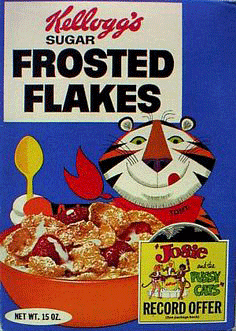 John
Kellogg founded the Santias Nut Company, making his younger brother the
chief executive officer, to sell the new cereal by mail. Success begets
imitation and by 1902, the Kelloggs had more than 40 competitors. Will
Keith Kellogg was much more aggressive in business than his brother, and
on April 1, 1906, he branched out on his own and established the Battle
Creek Toasted Corn Flake Company. Since then, for many Americans,
breakfast comes in a box. By the early 1900s dozens of cereal companies,
including rival Post, had opened factories in Battle Creek. John
Kellogg founded the Santias Nut Company, making his younger brother the
chief executive officer, to sell the new cereal by mail. Success begets
imitation and by 1902, the Kelloggs had more than 40 competitors. Will
Keith Kellogg was much more aggressive in business than his brother, and
on April 1, 1906, he branched out on his own and established the Battle
Creek Toasted Corn Flake Company. Since then, for many Americans,
breakfast comes in a box. By the early 1900s dozens of cereal companies,
including rival Post, had opened factories in Battle Creek.
It wasn't until after World War II that cereal companies began targeting
kids. In 1948, Post introduced its first sugar-coated cereal, Sugar
Crisp, along with an animated TV commercial, and its competitors quickly
followed suit. In 1951, Kellogg's unveiled its feline mascot Tony the
Tiger, who convinced kids all over the nation how "Grrr-r-rreat!" the
company's Frosted Flakes were. Sweetened cereals came to dominate the
market, bolstered by commercials in cartoon shows that helped
manufacturers hook generations of children to come.
Collecting Cereal Boxes
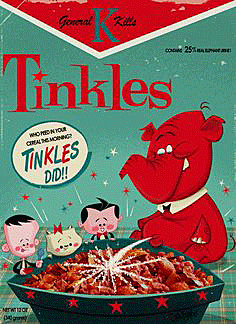 Like
collectors of many other items, from baseball cards to model trains,
nostalgia fuels cereal box aficionados. Many adults have vivid memories
of sitting around on Saturday mornings watching cartoons with a bowl of
Fruit Loops or Cocoa Puffs in front of them. Like
collectors of many other items, from baseball cards to model trains,
nostalgia fuels cereal box aficionados. Many adults have vivid memories
of sitting around on Saturday mornings watching cartoons with a bowl of
Fruit Loops or Cocoa Puffs in front of them.
Some collectors begin their cereal box collections by stashing away
unopened premiums—the prizes that come inside cereal boxes—in hopes
they'd be valuable someday. As it turns out, it's the boxes themselves
rather than the premiums that are typically worth more because fewer of
them have survived intact.
The cereal box's disposable nature seems to be one of the things that
attracts collectors, unlike baseball cards, which were never intended to
be saved. They're also colorful and easy to display. After all, people
who purchase Fruit Loops do so strictly in pursuit of the sugary little
“Os” inside. As soon as they eat them, they discard the packaging.
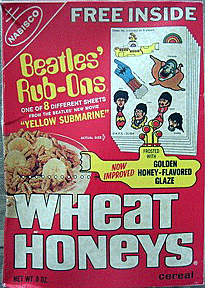 But
in the cereal box world, the oldest boxes aren't necessarily the most
valuable. The value of any cereal box is highly speculative. As with
other collectibles, a box’s value depends on what someone else is
willing to pay for it. But
in the cereal box world, the oldest boxes aren't necessarily the most
valuable. The value of any cereal box is highly speculative. As with
other collectibles, a box’s value depends on what someone else is
willing to pay for it.
Crossover collecting is also very common. A pair of boxes of Nabisco
Wheat Honeys and Rice Honeys from the late 1960s with a Beatles Yellow
Submarine tie-in fetched an online price of $11,000, most likely from a
collector of Beatles memorabilia rather than one who collects cereal
boxes. The same holds true for Star Wars collectors who collect
limited-edition Star Wars cereals, or sports memorabilia lovers who
collect Wheaties boxes.
The most desirable boxes are the ones with widest appeal, such as those
with popular cartoon characters and sports stars on them, and those
featuring a mail-in offer that could be sent off for some sort of
limited-edition prize, like a decoder ring or toy Navy boat. Often, the
cereal box market intersects with other popular collectible categories.
Superhero-themed boxes are very popular.
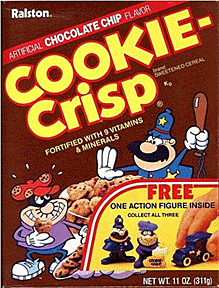 Before
online auctions and discussion forums, tracking down a rare cereal box
could require months or years of following leads from other collectors
and traveling to in-person swap meets. Today, collectors can do an eBay
search and pay for cereal boxes through Paypal or their credit card. Before
online auctions and discussion forums, tracking down a rare cereal box
could require months or years of following leads from other collectors
and traveling to in-person swap meets. Today, collectors can do an eBay
search and pay for cereal boxes through Paypal or their credit card.
For most cereal box collectors, the thrill of the hunt is what keeps
them going. The infinite varieties of cereal boxes, along with the
scarcity of most of them, is what keeps many collectors enthralled.
The variety of cereals and the countless premiums make this an ideal
collectible category. Some people try to collect them all while others
hunt certain sports or cartoon characters on the box covers.
The Cereal Box Market
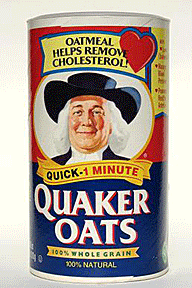 Prices
of cereal boxes range from as little as $5 for a Kellogg's Pep Wheat
Flakes box with a Linda Lou doll offer from 1969 to $1;000 for a British
Kellogg's Sugar Smacks from 1970 featuring Mr. Spock of Star Trek. A
Nabisco Wheat Honeys box from 1956, with Buffalo Bill on the front and
Rin-Tin-Tin 12-ring set on the back is worth about $125. A 1950 Quaker
Oats box, advertising a Roy Rogers Microscope Ring is valued at about
$80. A General Mills Cheerios box from 1980, featuring the Lone Ranger
on Silver, is worth about $40. All prices are for boxes in "mint"
condition. Prices
of cereal boxes range from as little as $5 for a Kellogg's Pep Wheat
Flakes box with a Linda Lou doll offer from 1969 to $1;000 for a British
Kellogg's Sugar Smacks from 1970 featuring Mr. Spock of Star Trek. A
Nabisco Wheat Honeys box from 1956, with Buffalo Bill on the front and
Rin-Tin-Tin 12-ring set on the back is worth about $125. A 1950 Quaker
Oats box, advertising a Roy Rogers Microscope Ring is valued at about
$80. A General Mills Cheerios box from 1980, featuring the Lone Ranger
on Silver, is worth about $40. All prices are for boxes in "mint"
condition.
One of the first stops for the novice or veteran cereal box collector
should be the local grocery store. Look for limited-run specials or
boxes linked to current events or events of regional interest.
Collectors in other areas of the country will be interested in swapping
boxes that didn’t appear in their regions.
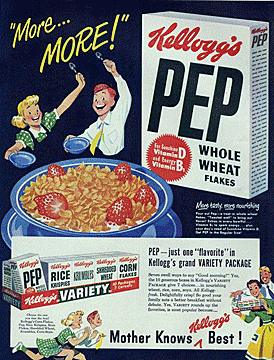 Cereal
box collectors also frequent sports, toy, and ephemera shows. Another
tried method of flushing cereal boxes out of attics and garages is
advertising in the classifieds of local newspapers and trade
publications. Many of the responses, unfortunately, might be about boxes
that are still on the store shelves, but, at the same time, a find, such
as a 1969 Nabisco Rice Honeys featuring The Beatles, worth as much as
$1,000, might surface. Cereal
box collectors also frequent sports, toy, and ephemera shows. Another
tried method of flushing cereal boxes out of attics and garages is
advertising in the classifieds of local newspapers and trade
publications. Many of the responses, unfortunately, might be about boxes
that are still on the store shelves, but, at the same time, a find, such
as a 1969 Nabisco Rice Honeys featuring The Beatles, worth as much as
$1,000, might surface.
So what do collectors do with all the cereal?. Some eat it while others
give it to local food banks. And some keep it right in the box. However,
many soon learn that doing so invites guests that may not otherwise
visit their homes.
<
Back to Readers Ask Archives
Next Article > |
